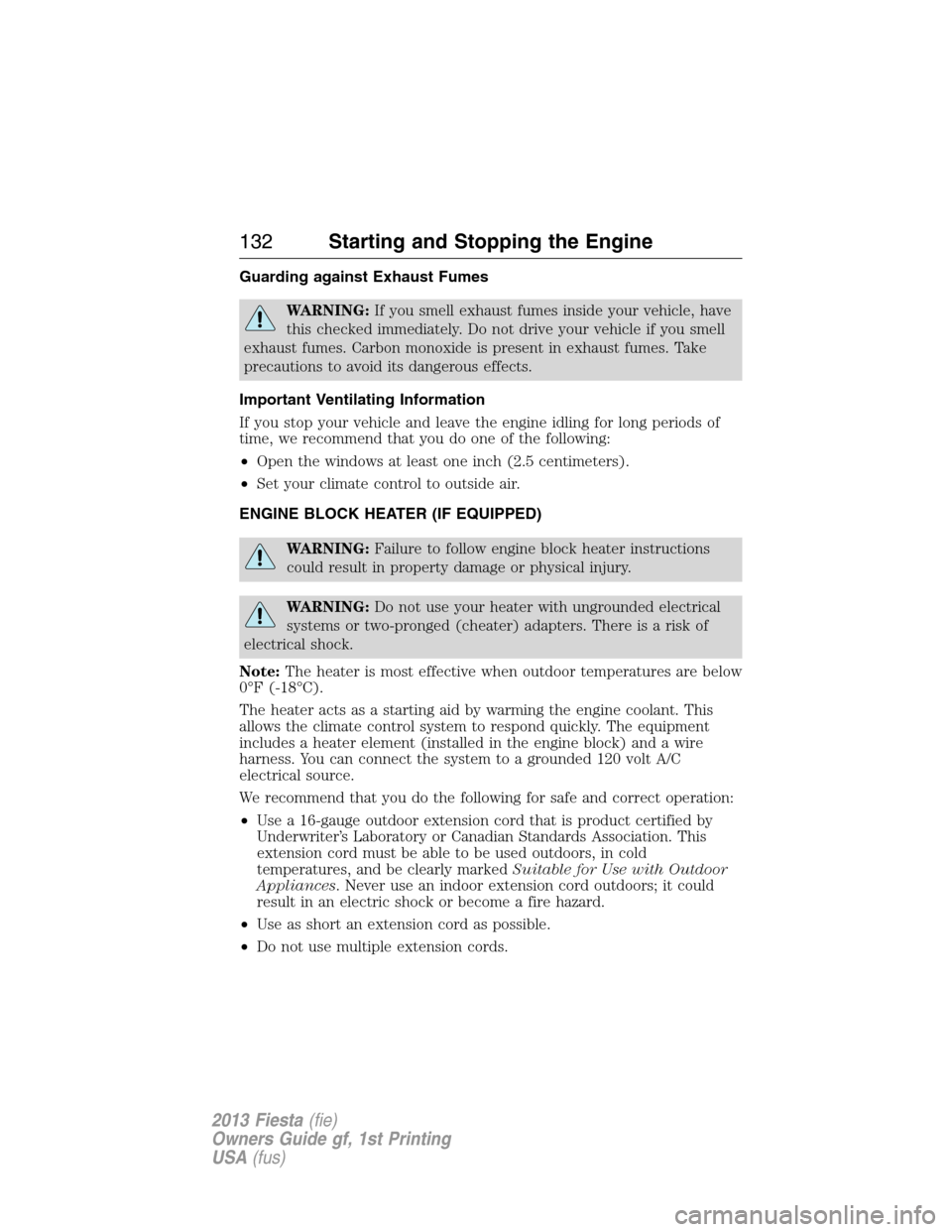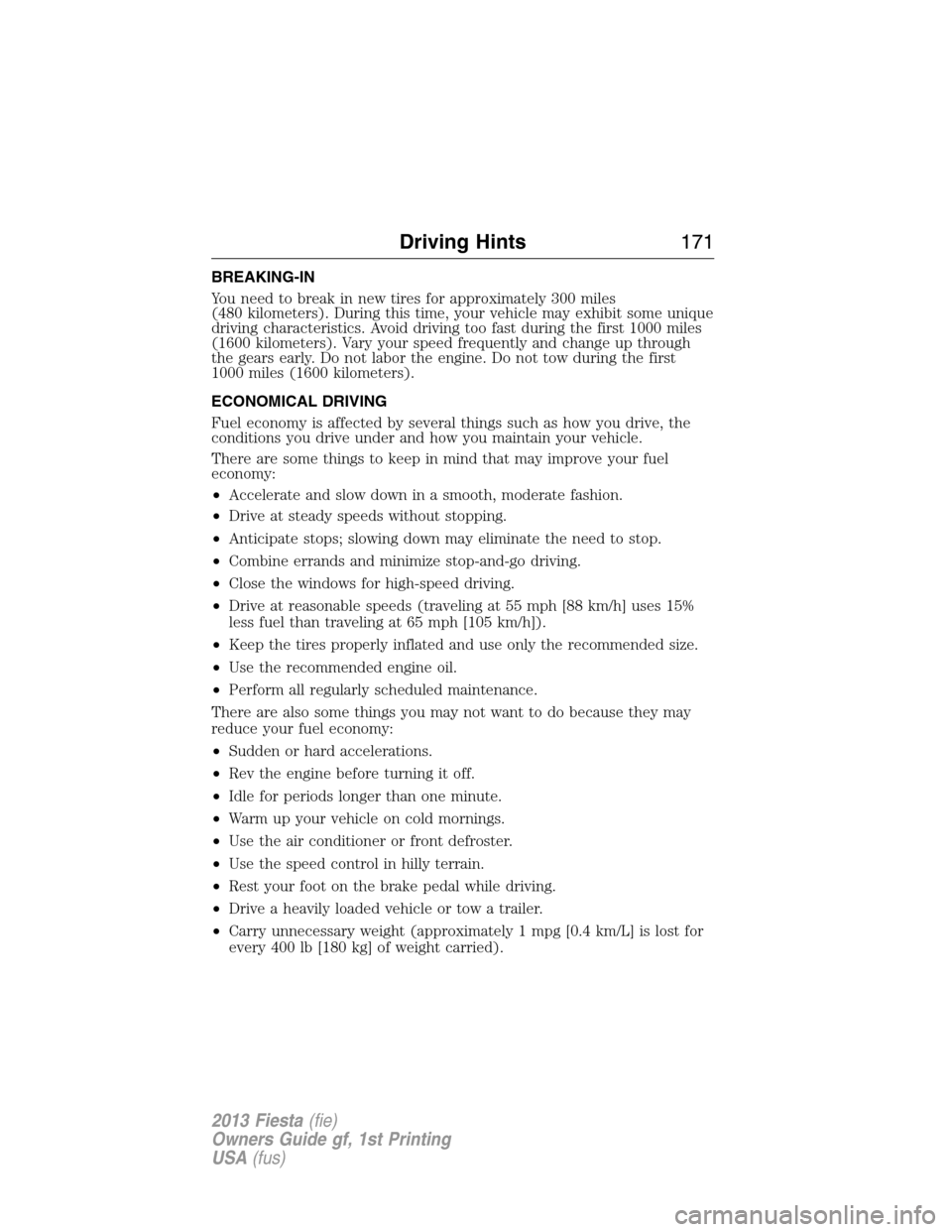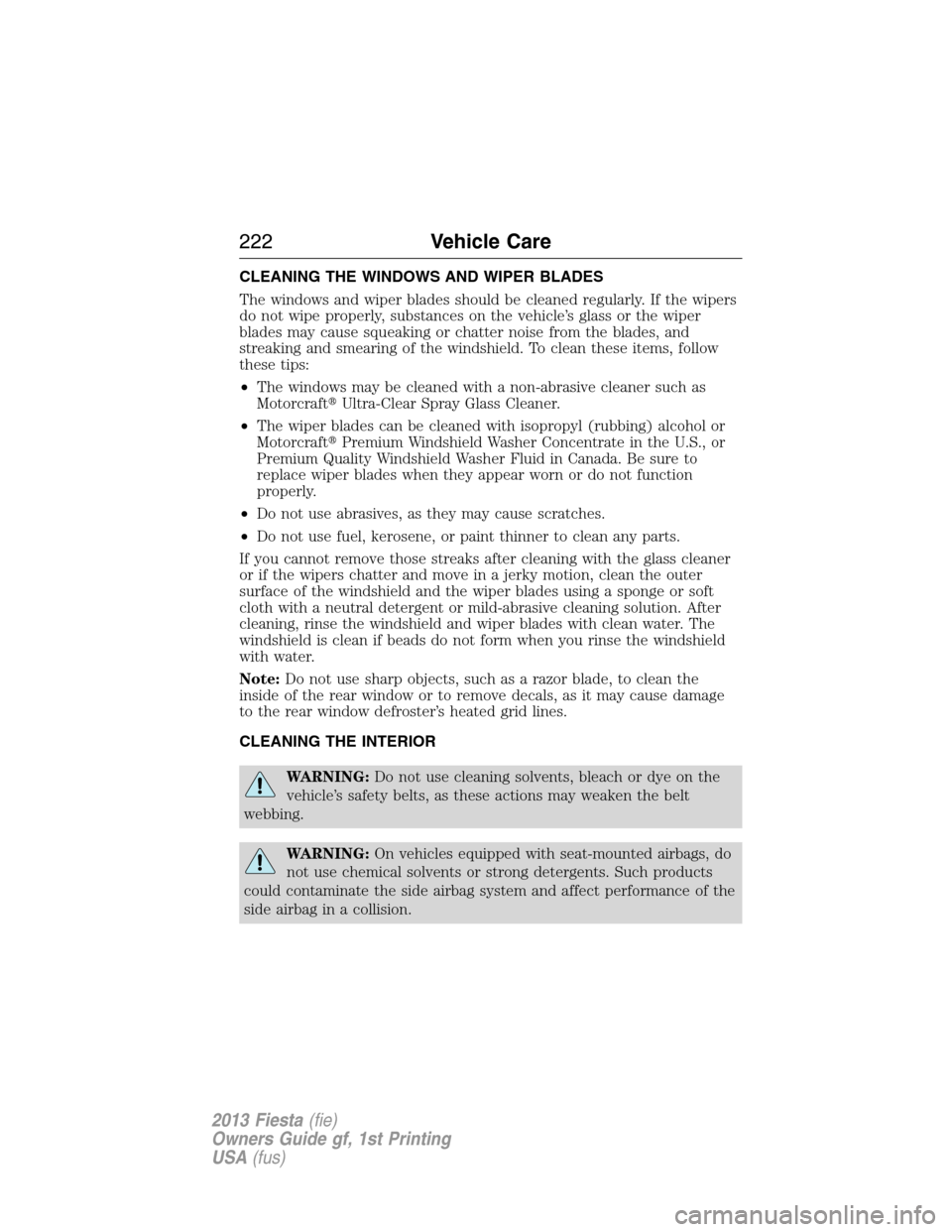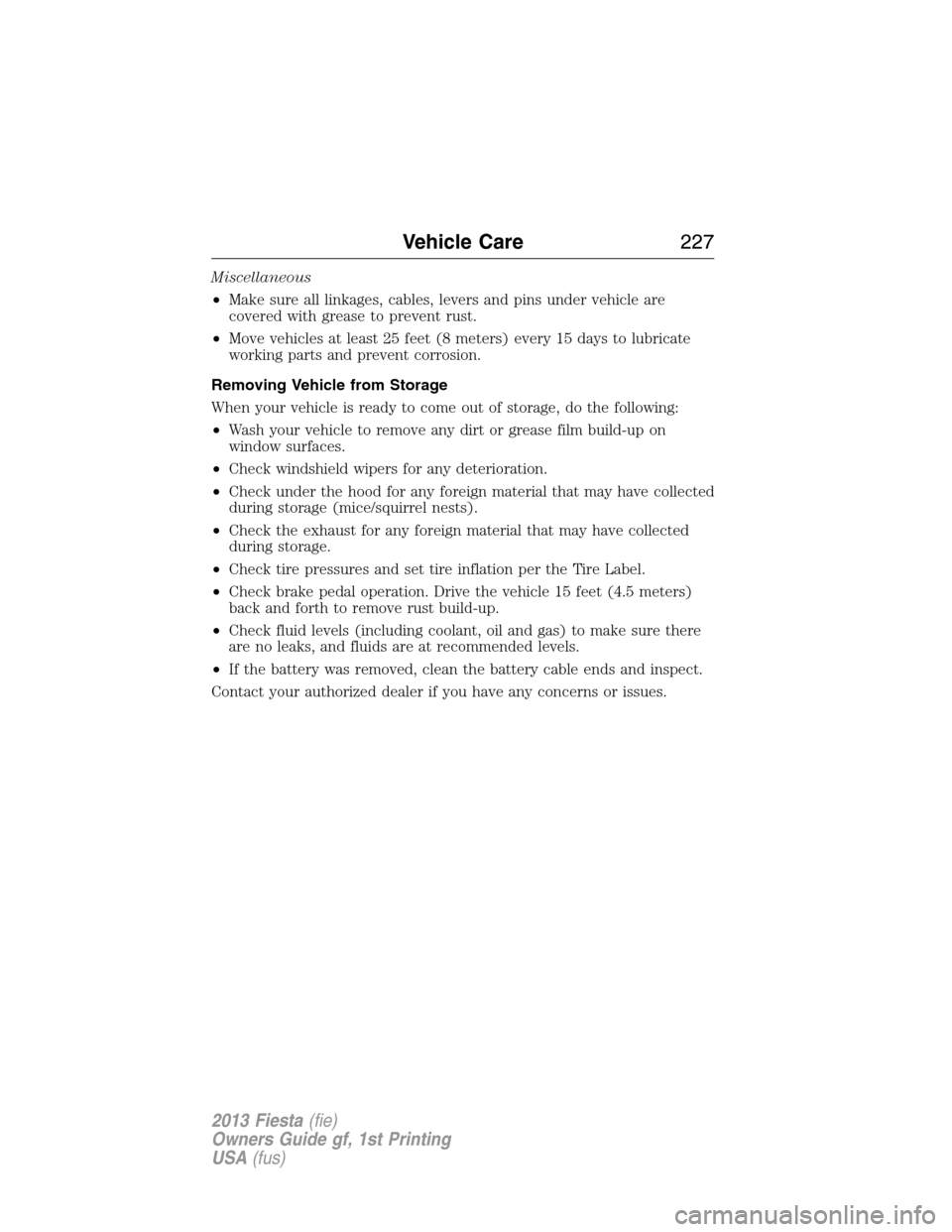Page 132 of 341

Guarding against Exhaust Fumes
WARNING:If you smell exhaust fumes inside your vehicle, have
this checked immediately. Do not drive your vehicle if you smell
exhaust fumes. Carbon monoxide is present in exhaust fumes. Take
precautions to avoid its dangerous effects.
Important Ventilating Information
If you stop your vehicle and leave the engine idling for long periods of
time, we recommend that you do one of the following:
•Open the windows at least one inch (2.5 centimeters).
•Set your climate control to outside air.
ENGINE BLOCK HEATER (IF EQUIPPED)
WARNING:Failure to follow engine block heater instructions
could result in property damage or physical injury.
WARNING:Do not use your heater with ungrounded electrical
systems or two-pronged (cheater) adapters. There is a risk of
electrical shock.
Note:The heater is most effective when outdoor temperatures are below
0°F (-18°C).
The heater acts as a starting aid by warming the engine coolant. This
allows the climate control system to respond quickly. The equipment
includes a heater element (installed in the engine block) and a wire
harness. You can connect the system to a grounded 120 volt A/C
electrical source.
We recommend that you do the following for safe and correct operation:
•Use a 16-gauge outdoor extension cord that is product certified by
Underwriter’s Laboratory or Canadian Standards Association. This
extension cord must be able to be used outdoors, in cold
temperatures, and be clearly markedSuitable for Use with Outdoor
Appliances. Never use an indoor extension cord outdoors; it could
result in an electric shock or become a fire hazard.
•Use as short an extension cord as possible.
•Do not use multiple extension cords.
132Starting and Stopping the Engine
2013 Fiesta(fie)
Owners Guide gf, 1st Printing
USA(fus)
Page 171 of 341

BREAKING-IN
You need to break in new tires for approximately 300 miles
(480 kilometers). During this time, your vehicle may exhibit some unique
driving characteristics. Avoid driving too fast during the first 1000 miles
(1600 kilometers). Vary your speed frequently and change up through
the gears early. Do not labor the engine. Do not tow during the first
1000 miles (1600 kilometers).
ECONOMICAL DRIVING
Fuel economy is affected by several things such as how you drive, the
conditions you drive under and how you maintain your vehicle.
There are some things to keep in mind that may improve your fuel
economy:
•Accelerate and slow down in a smooth, moderate fashion.
•Drive at steady speeds without stopping.
•Anticipate stops; slowing down may eliminate the need to stop.
•Combine errands and minimize stop-and-go driving.
•Close the windows for high-speed driving.
•Drive at reasonable speeds (traveling at 55 mph [88 km/h] uses 15%
less fuel than traveling at 65 mph [105 km/h]).
•Keep the tires properly inflated and use only the recommended size.
•Use the recommended engine oil.
•Perform all regularly scheduled maintenance.
There are also some things you may not want to do because they may
reduce your fuel economy:
•Sudden or hard accelerations.
•Rev the engine before turning it off.
•Idle for periods longer than one minute.
•Warm up your vehicle on cold mornings.
•Use the air conditioner or front defroster.
•Use the speed control in hilly terrain.
•Rest your foot on the brake pedal while driving.
•Drive a heavily loaded vehicle or tow a trailer.
•Carry unnecessary weight (approximately 1 mpg [0.4 km/L] is lost for
every 400 lb [180 kg] of weight carried).
Driving Hints171
2013 Fiesta(fie)
Owners Guide gf, 1st Printing
USA(fus)
Page 191 of 341
Fuse/Relay
NumberFuse Amp
RatingProtected Components
F22 15A** Mass air flow sensor, Powertrain
control module, Fuel injectors,
Vehicle speed sensor, Variable
camshaft timing, Canister purge
F23 15A** Daytime running lights
F24 — Not used
F25 15A** Body control module – exterior
lighting
F26 20A** Body control module – battery
saver, horn
F27 — Not used
F28 15A** Body control module – turn
signals
F29 — Not used
F30 10A** A/C clutch solenoid and relay
F31 — Not used
F32 7.5A** Transmission control module,
Powertrain control module
F33 15A** Ignition coil
F34 30A** Body control module – rear
window defroster
F35 10A** Left headlamp (low beam)
F36 10A** Right headlamp (low beam)
F37 10A** Left headlamp (high beam)
F38 10A** Right headlamp (high beam)
F39 2A** Natural vacuum leak detection
F40 — Not used
F41 — Not used
F42 — Not used
F43 — Not used
F44 — Not used
F45 — Not used
Fuses191
2013 Fiesta(fie)
Owners Guide gf, 1st Printing
USA(fus)
Page 194 of 341

Fuse/Relay
NumberFuse Amp
RatingProtected Components
F7 7.5A Instrument panel display,
Intelligent access antenna, Manual
climate controls
F8 7.5A Front dome lamp, Moonroof
F9 20A Keyless vehicle module
F10 15A Radio, SYNC�module, Global
positioning system module
F11 20A Body control module – front
wipers
F12 20A Tire pressure monitoring system
F13 15A Body control module – rear wiper
F14 20A Intelligent access module
F15 15A Wiper switch
F16 7.5A Power mirror switch, Driver
window switch
F17 15A Heated seats
F18 10A Stop lamps, Turn signals
F19 7.5A Instrument cluster
F20 10A Airbag module
F21 10A Body control module – ignition
switch, Climate control, Passive
anti-theft system transceiver,
Electronic power steering module,
Instrument cluster, Engine
compartment fuse panel
F22 7.5A Accelerator pedal position sensor,
Powertrain control module, Gear
shifter, Anti-lock brake system
ignition feed
F23 10A Transmission control unit ignition
feed, Tire pressure monitoring
system ignition feed
194Fuses
2013 Fiesta(fie)
Owners Guide gf, 1st Printing
USA(fus)
Page 195 of 341
Fuse/Relay
NumberFuse Amp
RatingProtected Components
F24 — Not used
F25 7.5A Exterior mirrors
F26 7.5A Tire pressure monitoring system
F27 — Not used
F28 — Not used
F29 — Not used
F30 — Not used
F31 30A Rear power window switches
F32 20A Passenger compartment fuse
panel battery saver relay
F33 20A Power points
F34 30A Front power window switches
F35 20A Moonroof
F36 — Not used
R1 — Ignition relay
R2 — Left rear stop/turn lamp relay
(4-door only)
R3 — Right rear stop/turn lamp relay
(4-door only)
R4 — Driver heated seat relay
R5 — Passenger heated seat relay
R6 — Intelligent access module –
accessory relay
R7 — Intelligent access module –
ignition relay
R8 — Battery saver relay, Rear
powerpoints
R9 — Not used
Fuses195
2013 Fiesta(fie)
Owners Guide gf, 1st Printing
USA(fus)
Page 207 of 341

CHANGING THE WIPER BLADES
1. Pull the wiper arm away from the
windshield.
2. Press the locking button.
3. Remove the wiper blade.
Note:Make sure the wiper blade locks into place.
Replace wiper blades at least once per year for optimum performance.
Poor wiper quality can be improved by cleaning the wiper blades and the
windshield.
To prolong the life of the wiper blades, it is highly recommended to
scrape off the ice on the windshield before turning on the wipers. The
layer of ice has many sharp edges and can damage the micro edge of the
wiper rubber element.
Changing Rear Window Wiper Blade
To replace the rear wiper blade:
1. Lift and hold the wiper blade off
the glass.
2. Position the wiper blade at right angles to the wiper arm.
3. Disengage the wiper blade from the wiper arm.
4. Remove the wiper blade.
Note:Make sure that the wiper blade locks into place.
Install the wiper blade in the reverse order.
3
2
3
4
2
Maintenance207
2013 Fiesta(fie)
Owners Guide gf, 1st Printing
USA(fus)
Page 222 of 341

CLEANING THE WINDOWS AND WIPER BLADES
The windows and wiper blades should be cleaned regularly. If the wipers
do not wipe properly, substances on the vehicle’s glass or the wiper
blades may cause squeaking or chatter noise from the blades, and
streaking and smearing of the windshield. To clean these items, follow
these tips:
•The windows may be cleaned with a non-abrasive cleaner such as
Motorcraft�Ultra-Clear Spray Glass Cleaner.
•The wiper blades can be cleaned with isopropyl (rubbing) alcohol or
Motorcraft�Premium Windshield Washer Concentrate in the U.S., or
Premium Quality Windshield Washer Fluid in Canada. Be sure to
replace wiper blades when they appear worn or do not function
properly.
•Do not use abrasives, as they may cause scratches.
•Do not use fuel, kerosene, or paint thinner to clean any parts.
If you cannot remove those streaks after cleaning with the glass cleaner
or if the wipers chatter and move in a jerky motion, clean the outer
surface of the windshield and the wiper blades using a sponge or soft
cloth with a neutral detergent or mild-abrasive cleaning solution. After
cleaning, rinse the windshield and wiper blades with clean water. The
windshield is clean if beads do not form when you rinse the windshield
with water.
Note:Do not use sharp objects, such as a razor blade, to clean the
inside of the rear window or to remove decals, as it may cause damage
to the rear window defroster’s heated grid lines.
CLEANING THE INTERIOR
WARNING:Do not use cleaning solvents, bleach or dye on the
vehicle’s safety belts, as these actions may weaken the belt
webbing.
WARNING:On vehicles equipped with seat-mounted airbags, do
not use chemical solvents or strong detergents. Such products
could contaminate the side airbag system and affect performance of the
side airbag in a collision.
222Vehicle Care
2013 Fiesta(fie)
Owners Guide gf, 1st Printing
USA(fus)
Page 227 of 341

Miscellaneous
•Make sure all linkages, cables, levers and pins under vehicle are
covered with grease to prevent rust.
•Move vehicles at least 25 feet (8 meters) every 15 days to lubricate
working parts and prevent corrosion.
Removing Vehicle from Storage
When your vehicle is ready to come out of storage, do the following:
•Wash your vehicle to remove any dirt or grease film build-up on
window surfaces.
•Check windshield wipers for any deterioration.
•Check under the hood for any foreign material that may have collected
during storage (mice/squirrel nests).
•Check the exhaust for any foreign material that may have collected
during storage.
•Check tire pressures and set tire inflation per the Tire Label.
•Check brake pedal operation. Drive the vehicle 15 feet (4.5 meters)
back and forth to remove rust build-up.
•Check fluid levels (including coolant, oil and gas) to make sure there
are no leaks, and fluids are at recommended levels.
•If the battery was removed, clean the battery cable ends and inspect.
Contact your authorized dealer if you have any concerns or issues.
Vehicle Care227
2013 Fiesta(fie)
Owners Guide gf, 1st Printing
USA(fus)